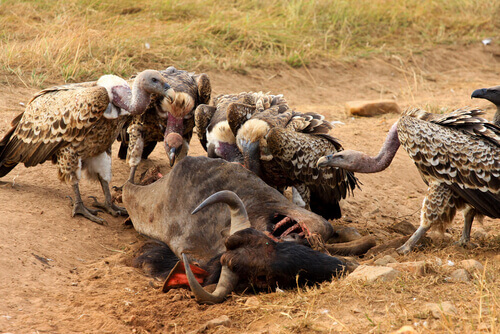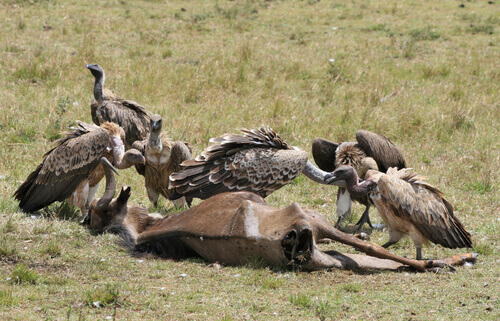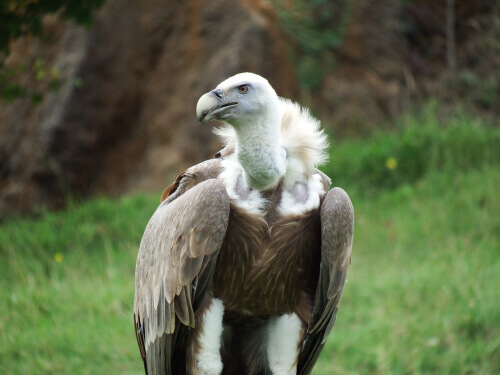The Midden: A Feasting Place for Carrion Eaters

A midden is a place where livestock farmers can leave the carcasses of livestock. They do this for carrion eaters and other scavengers to feed upon the dead bodies. One of the most interesting cases is that of the various species of vultures in Spain.
The importance of a place for carrion eaters
A midden allows for the sustainable recycling of carcasses, which has been going on for thousands of years. A large livestock herd produces more carcasses than normal, which can cause intoxication due to the contamination of water sources.
This is why scavengers and the presence of a midden in our environment are very important for the ecosystem. Despite that in recent years middens had started to disappear due to the mad cow crisis, the truth is that they are regaining importance. Every day, more and more communities allow the abandonment of carcasses in the outskirts.
Guests at the midden banquet
Normally, middens are fenced to prevent the access of people and domestic animals. This usually prevents the access of terrestrial carnivores. However, there are areas where carcasses are abandoned without any barriers. As a result, the Iberian wolf, the brown bear, or small carnivores such as martens and civet cats can benefit from visiting a place for carrion eaters.
However, the main beneficiaries of these places are the birds of prey or carrion-eating birds. The abundant griffon vulture, the small Egyptian vulture, the great black vulture, or the bearded vulture are species of vultures that abound in Spain and other European countries, and are the main protagonists of the banquet.

There are also other birds that visit a midden. Kites are usually regulars, and along with magpies, crows, and blackbirds, they complete the feast party. Nevertheless, other birds such as buzzards can also take advantage of the presence of a midden.
The midden protocol
The first thing to do is to locate the food, and for that, the greatest specialists are the corvids: magpies, rails, and crows. These birds usually fly in groups checking the terrain until they find a carcass. This is when the corvids take the opportunity to feed on the soft parts, such as the tongue or eyes, as they need a stronger beak to open up the price.
These birds have something in common, and their greatest exponent is the magpie: they’re noisy animals with a colorful plumage, which even flashes in the morning sun. This sun is necessary for the vultures to take flight, as they take advantage of the warm air currents. In addition, the sunlight also allows them to locate the carcass.
The flashes from the carcasses are very conspicuous and can be seen from dozens of miles away. In fact, they’re conspicuous enough for the vultures to locate the animal and make a move for it.
In addition, vultures have to communicate with each other from many miles away and bring dozens of them together for an incredible feast. But, how do they do it?
The banquet begins
Vultures will begin to fly in a different way and descend in circles towards the carcass. They will turn in a particular way that the other vultures will notice as a sign that there is a carcass. Thus, each vulture changes its way of flying and warns the others without the need for any sounds.

This behavior isn’t so common in the black vulture, which is more given to solitude than the griffon vulture. We can find it in some environments such as Monfragüe. However, it’s good for the griffon vulture that the black vulture arrives, as the stronger beak of the largest flying bird in Europe allows for a clean opening of the carcass.
After the opening, the black vulture feasts on the flesh around the wound. However, it won’t be able to reach the bottom of the carcass due to the abundant plumage around its neck. It’s then that the griffon vulture makes its move. With an almost bare neck, it will dive to the bottom of the carcass in search of viscera and other parts.
The vultures then begin to feed in batches. It’s worth noting that nothing is done randomly, although these congregations often seem chaotic. Nevertheless, there may be fights between the animals, usually between the black and griffon vulture. This is because the former wants to return to the feast after the griffon has finally released access to the inside of the carcass.
Other guests
Other birds will surround the congregation: red kites and some other bigger birds of prey will try to get their share. However, they have already made a few bites at the beginning. Of course, they’re no match for the vultures despite being better hunters, so they keep their distance waiting for them to leave.
Meanwhile, the corvids are still the smartest carrion-eating guests. Thanks to their small size, they can go unnoticed and walk among the vultures with confidence. The carcass will be quickly cleaned up, and the cycle of life will continue.
